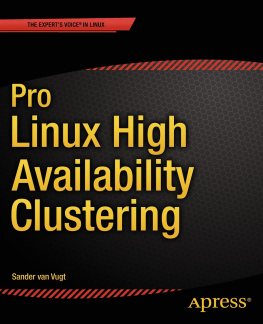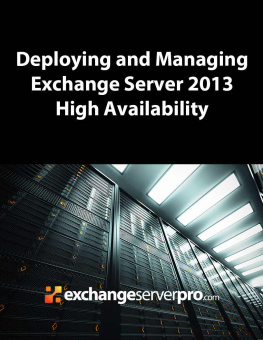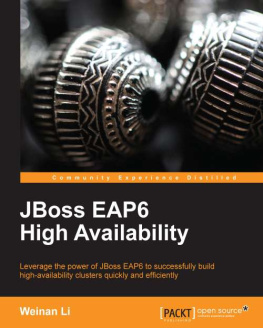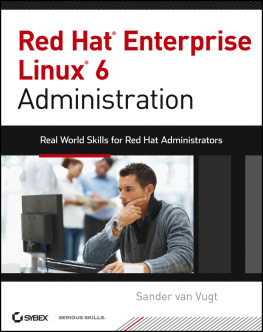Sander van Vugt
ISBN 978-1-4842-0080-3 e-ISBN 978-1-4842-0079-7
DOI 10.1007/978-1-4842-0079-7
Apress 2014
Pro Linux High Availability Clustering
Publisher: Heinz Weinheimer
Lead Editor: Louise Corrigan
Technical Reviewers: Menno van Saagsvelt, Lars Marowsky-Bre
Editorial Board: Steve Anglin, Mark Beckner, Ewan Buckingham, Gary Cornell, Louise Corrigan, Jim DeWolf, Jonathan Gennick, Jonathan Hassell, Robert Hutchinson, Michelle Lowman, James Markham, Matthew Moodie, Jeff Olson, Jeffrey Pepper, Douglas Pundick, Ben Renow-Clarke, Dominic Shakeshaft, Gwenan Spearing, Matt Wade, Steve Weiss
Coordinating Editor: Christine Ricketts
Copy Editor: Michael G. Laraque
Compositor: SPi Global
Indexer: SPi Global
Artist: SPi Global
Cover Designer: Anna Ishchenko
Distributed to the book trade worldwide by Springer Science+Business Media New York, 233 Spring Street, 6th Floor, New York, NY 10013. Phone 1-800-SPRINGER, fax (201) 348-4505, e-mail orders-ny@springer-sbm.com , or visit www.springeronline.com . Apress Media, LLC is a California LLC and the sole member (owner) is Springer Science+Business Media Finance Inc (SSBM Finance Inc). SSBM Finance Inc is a Delaware corporation.
For information on translations, please e-mail rights@apress.com , or visit www.apress.com .
Apress and friends of ED books may be purchased in bulk for academic, corporate, or promotional use. eBook versions and licenses are also available for most titles. For more information, reference our Special Bulk SaleseBook Licensing web page at www.apress.com/bulk-sales .
Any source code or other supplementary material referenced by the author in this text is available to readers at www.apress.com . For detailed information about how to locate your books source code, go to www.apress.com/source-code/ .
This work is subject to copyright. All rights are reserved by the Publisher, whether the whole or part of the material is concerned, specifically the rights of translation, reprinting, reuse of illustrations, recitation, broadcasting, reproduction on microfilms or in any other physical way, and transmission or information storage and retrieval, electronic adaptation, computer software, or by similar or dissimilar methodology now known or hereafter developed. Exempted from this legal reservation are brief excerpts in connection with reviews or scholarly analysis or material supplied specifically for the purpose of being entered and executed on a computer system, for exclusive use by the purchaser of the work. Duplication of this publication or parts thereof is permitted only under the provisions of the Copyright Law of the Publishers location, in its current version, and permission for use must always be obtained from Springer. Permissions for use may be obtained through RightsLink at the Copyright Clearance Center. Violations are liable to prosecution under the respective Copyright Law.Trademarked names, logos, and images may appear in this book. Rather than use a trademark symbol with every occurrence of a trademarked name, logo, or image, we use the names, logos, and images only in an editorial fashion and to the benefit of the trademark owner, with no intention of infringement of the trademark.The use in this publication of trade names, trademarks, service marks, and similar terms, even if they are not identified as such, is not to be taken as an expression of opinion as to whether or not they are subject to proprietary rights.While the advice and information in this book are believed to be true and accurate at the date of publication, neither the author nor the editors nor the publisher can accept any legal responsibility for any errors or omissions that may be made. The publisher makes no warranty, express or implied, with respect to the material contained herein.
The use of general descriptive names, registered names, trademarks, service marks, etc. in this publication does not imply, even in the absence of a specific statement, that such names are exempt from the relevant protective laws and regulations and therefore free for general use.
Introduction
This book is about high availability (HA) clustering on Linux, a subject that can be overwhelming to administrators who are new to the subject. Although much documentation is already available on the subject, I felt a need to write this book anyway. The most important reason is that I feel there is a lack of integral documentation that focuses on tasks that have to be accomplished by cluster administrators. With this book, I have tried to provide insight into accomplishing all of the tasks that a cluster administrator typically has to deal with.
This means that Im not only focusing on the clustering software itself but also on setting up the network for redundancy and configuring storage for use in a clustered environment. In an attempt to make this book as useful as possible, I have also included three chapters with use cases, at the end of this book.
When working with HA on Linux, administrators will encounter different challenges. One of these is that even if the core components Corosync and Pacemaker are used on nearly all recent Linux distributions, there are many subtle differences.
Instead of using the same solutions, the two most important enterprise Linux distributions that are offering commercially supported HA also want to guarantee a maximum of compatibility with their previous solutions, to make the transition for their customers as easy as possible, and that is revealed by slight differences. For example, Red Hat uses fencing and SUSE uses STONITH, and even if both do the same thing, they are doing it in a slightly different way. For a cluster administrator, it is important to be acutely aware of these differences, because they may cause many practical problems, most of which I have tried to describe in this book.

 Menno van Saagsvelt works as a senior technical consultant for a company in the Netherlands, providing e-learning solutions for (big) companies (especially Moodle, on clustered LAMP-stacks).
Menno van Saagsvelt works as a senior technical consultant for a company in the Netherlands, providing e-learning solutions for (big) companies (especially Moodle, on clustered LAMP-stacks).










